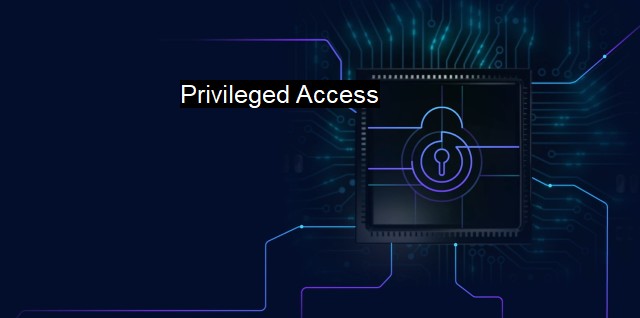What are Privileged Access?
Protecting Your Organization's Sensitive Data with Privileged Access Management: Mitigating Cyber Threats and Controlling User Access
Privileged access denotes the permissions that determine rights or system access for users with critical responsibilities. These users, or privileged users, may encompass network administrators, IT executives, data analysts or even application developers, who require an in-depth reach into the organization's systems and databases to ensure effective operations, maintenance, and security. While it's crucial for privileged users to have substantial authority in managing various postures of the digital infrastructure, hiccups in privileged access control can expose an organization to significant security risks.Notably, privileged access focuses on managing and controlling access to an organization's critical assets. This access can apply to devices, applications, databases, and other parts of the IT infrastructure that are critical for business operations. The core idea of privileged access is rooted in the principle of least privilege (PoLP), promoting the limitation of an individual's system access to bare minimum functionalities required to perform their job effectively. From requesting a password reset to installing new applications or modifying system files, these processes necessitate privileged rights, thereby increasing the need for robust privileged access controls.
The universality of the concept indeed reflects why privileged access is considered a critical cybersecurity control. If unauthorized individuals or entities gain privileged access to systems or networks, they may exploit it to breach sensitive information, disrupt services, or even introduce malicious software such as viruses, ransomware, or other types of malware.
The world has seen various calamitous instances where attackers breached the privileged access wall. Many viruses, including ransomware, capture the opportunity to seize control over resources and manipulate security settings, often causing far-reaching and grave implications on the victims. The infamous NotPetya ransomware is a classic case of how ransomware can escalate and abuse Windows' privileged access to spread laterally across an organization's network.
In response to such risks, Implementing Privileged Access Management (PAM) has found prominence in cybersecurity strategies. PAM is a specialized solution that aids organizations in defining, implementing, and enforcing their privileged access strategy. It includes gathering data on who has access to what, tracing and logging all the activities, removing redundant accounts, and providing robust control over sharing and managing passwords.
Typically, PAM solutions apply sophisticated technology to combat complex privileged access threats, such as session management, which monitors and securely records every session activity, and behavior analytics that identify abnormal user behavior based on usual preference data.
The concept of privileged access demonstrates that managing system and network security isn't only about installing antivirus software and erecting firewalls. Instead, it calls for end-to-end protection, monitoring, and management of each user's footprint, chiefly amongst individuals who maintain considerable authority across the IT landscape.
Circling back to antivirus software perspective, the comprehensive understanding of privileged access is of the utmost importance. Antivirus software generally requires critical system access to perform its function, having privileged access enables this software to inspect possible vulnerabilities and intercept threats before they cause damage.
“privileged access” plays a critical role with instrumental to antivirus software, as it encompasses the authority and the rights to perform specific actions or access certain information within a network. Consequently, privileged access management emerges as a critical facet of protecting and managing an organization's IT infrastructure, stressing the vitality of optimally balanced and secure privileged access in safeguarding against cybersecurity threats.

Privileged Access FAQs
What is privileged access in the context of cybersecurity?
Privileged access refers to the level of access that allows a user to perform administrative actions on a system. This access is typically reserved for a small number of users who require it to perform critical tasks such as installing software, modifying system configurations, or managing user permissions.Why is privileged access a security concern?
Privileged access can be exploited by cybercriminals to gain access to sensitive data, compromise systems, and disrupt business operations. Attackers may use stolen or compromised privileged credentials to move laterally within a network and gain access to additional systems and data.How can organizations mitigate the risks associated with privileged access?
Organizations can implement a variety of security controls to manage privileged access, such as implementing multi-factor authentication, restricting access to systems based on job responsibilities, and monitoring user activity for suspicious behavior. Additionally, implementing a strong antivirus solution can help detect and prevent malware that targets privileged accounts.What are the best practices for managing privileged access?
Best practices for managing privileged access include limiting the number of privileged accounts, implementing least privilege access policies, regularly auditing privileged access, and ensuring that passwords for privileged accounts are complex and regularly rotated. Organizations should also consider implementing a privileged access management solution to automate the process of granting and revoking access and monitoring user activity.| | A | | | B | | | C | | | D | | | E | | | F | | | G | | | H | | | I | | | J | | | K | | | L | | | M | |
| | N | | | O | | | P | | | Q | | | R | | | S | | | T | | | U | | | V | | | W | | | X | | | Y | | | Z | |
| | 1 | | | 2 | | | 3 | | | 4 | | | 7 | | | 8 | | |||||||